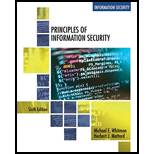
Principles of Information Security (MindTap Course List)
6th Edition
ISBN: 9781337102063
Author: Michael E. Whitman, Herbert J. Mattord
Publisher: Cengage Learning
expand_more
expand_more
format_list_bulleted
Expert Solution & Answer
Chapter 10, Problem 16RQ
Explanation of Solution
Negative feedback loop:
Negative feedback loop is also known as gap analysis or cybernetic loop. Once the project is under way then it is controlled by using this loop process and also it make sure that the project is measured periodically.
- Negative feedback loop is a loop for computing the progress and comparing that progress with projected outcome.
- If the progress is found to be unacceptable, then highlights the negative feedback process and corrective measures wants to be taken to bring the project back to form...
Expert Solution & Answer
Trending nowThis is a popular solution!

Students have asked these similar questions
Please answer the exercise below(C programme)
I need to list and know about some local storage options available in Windows Server 2019, thank you
Please answer both Exercise 1 and2(these questions are not GRADED)
Chapter 10 Solutions
Principles of Information Security (MindTap Course List)
Ch. 10 - Prob. 1RQCh. 10 - What is the value of a statement of vision and...Ch. 10 - Prob. 3RQCh. 10 - List and describe the three major steps in...Ch. 10 - What is a work breakdown structure (WBS)? Is it...Ch. 10 - What is projectitis? How is it cured or its impact...Ch. 10 - Prob. 7RQCh. 10 - Prob. 8RQCh. 10 - Prob. 9RQCh. 10 - Prob. 10RQ
Ch. 10 - Prob. 11RQCh. 10 - Prob. 12RQCh. 10 - Why is it good practice to assign start and end...Ch. 10 - Who is the best judge of effort estimates for...Ch. 10 - Prob. 15RQCh. 10 - Prob. 16RQCh. 10 - Prob. 17RQCh. 10 - Prob. 18RQCh. 10 - Prob. 19RQCh. 10 - Prob. 20RQCh. 10 - Write a job description for Kelvin Urich, the...Ch. 10 - Search the Web for job descriptions of project...Ch. 10 - What project management tasks should Kelvin...Ch. 10 - What change management tasks should Kelvin perform...Ch. 10 - Prob. 3CEDQCh. 10 - Prob. 1EDM
Knowledge Booster
Similar questions
- Discussion 1. Comment on your results. 2. Compare between the practical and theoretical results. 3. Find VB, Vc on the figure below: 3V V₁₁ R₁ B IR, R, IR, R www ΙΚΩ www www I 1.5KQ 18₁ 82002 R₁ 3.3KQ R₂ 2.2KQ E Darrow_forwardAgile1. a. Describe it and how it differs from other SDLC approachesb. List and describe the two primary terms for the agile processc. What are the three activities in the Construction phasearrow_forwardhow are youarrow_forward
- need help with thi Next, you are going to combine everything you've learned about HTML and CSS to make a static site portfolio piece. The page should first introduce yourself. The content is up to you, but should include a variety of HTML elements, not just text. This should be followed by an online (HTML-ified) version of your CV (Resume). The following is a minimum list of requirements you should have across all your content: Both pages should start with a CSS reset (imported into your CSS, not included in your HTML) Semantic use of HTML5 sectioning elements for page structure A variety other semantic HTML elements Meaningful use of Grid, Flexbox and the Box Model as appropriate for different layout components A table An image Good use of CSS Custom Properties (variables) Non-trivial use of CSS animation Use of pseudeo elements An accessible colour palette Use of media queries The focus of this course is development, not design. However, being able to replicate a provided design…arrow_forwardUsing the notationarrow_forwardyou can select multipy optionsarrow_forwardFor each of the following, decide whether the claim is True or False and select the True ones: Suppose we discover that the 3SAT can be solved in worst-case cubic time. Then it would mean that all problems in NP can also be solved in cubic time. If a problem can be solved using Dynamic Programming, then it is not NP-complete. Suppose X and Y are two NP-complete problems. Then, there must be a polynomial-time reduction from X to Y and also one from Y to X.arrow_forwardMaximum Independent Set problem is known to be NP-Complete. Suppose we have a graph G in which the maximum degree of each node is some constant c. Then, is the following greedy algorithm guaranteed to find an independent set whose size is within a constant factor of the optimal? 1) Initialize S = empty 2) Arbitrarily pick a vertex v, add v to S delete v and its neighbors from G 3) Repeat step 2 until G is empty Return S Yes Noarrow_forwardPlease help me answer this coding question in the images below for me(it is not a graded question):write the code using python and also provide the outputs requiredarrow_forwardWhat does the reduction showing Vertex Cover (VC) is NP-Complete do: Transforms any instance of VC to an instance of 3SAT Transforms any instance of 3SAT to an instance of VC Transforms any instance of VC to an instance of 3SAT AND transforms any instance of 3SAT to an instance of VC none of the abovearrow_forwardPlease assist me by writing out the code with its output (in python) using the information provided in the 2 images below.for the IP Address, it has been changed to: 172.21.5.204the serve code has not been open yet though but the ouput must be something along these lines(using command prompt):c:\Users\japha\Desktop>python "Sbongakonke.py"Enter the server IP address (127.0.0.1 or 172.21.5.199): 172.21.5.204Enter your student number: 4125035Connected to server!It's your turn to pour! Enter the amount to your pour (in mL):Please work it out until it gets the correct outputsNB: THIS QUESTION IS NOT A GRADED QUESTIONarrow_forwardneed help with a html code and css code that will match this image.arrow_forwardarrow_back_iosSEE MORE QUESTIONSarrow_forward_ios
Recommended textbooks for you
 Principles of Information Security (MindTap Cours...Computer ScienceISBN:9781337102063Author:Michael E. Whitman, Herbert J. MattordPublisher:Cengage Learning
Principles of Information Security (MindTap Cours...Computer ScienceISBN:9781337102063Author:Michael E. Whitman, Herbert J. MattordPublisher:Cengage Learning Principles of Information Systems (MindTap Course...Computer ScienceISBN:9781305971776Author:Ralph Stair, George ReynoldsPublisher:Cengage Learning
Principles of Information Systems (MindTap Course...Computer ScienceISBN:9781305971776Author:Ralph Stair, George ReynoldsPublisher:Cengage Learning Information Technology Project ManagementComputer ScienceISBN:9781337101356Author:Kathy SchwalbePublisher:Cengage Learning
Information Technology Project ManagementComputer ScienceISBN:9781337101356Author:Kathy SchwalbePublisher:Cengage Learning Management Of Information SecurityComputer ScienceISBN:9781337405713Author:WHITMAN, Michael.Publisher:Cengage Learning,
Management Of Information SecurityComputer ScienceISBN:9781337405713Author:WHITMAN, Michael.Publisher:Cengage Learning, Principles of Information Systems (MindTap Course...Computer ScienceISBN:9781285867168Author:Ralph Stair, George ReynoldsPublisher:Cengage Learning
Principles of Information Systems (MindTap Course...Computer ScienceISBN:9781285867168Author:Ralph Stair, George ReynoldsPublisher:Cengage Learning Information Technology Project ManagementComputer ScienceISBN:9781285452340Author:Kathy SchwalbePublisher:Cengage Learning
Information Technology Project ManagementComputer ScienceISBN:9781285452340Author:Kathy SchwalbePublisher:Cengage Learning

Principles of Information Security (MindTap Cours...
Computer Science
ISBN:9781337102063
Author:Michael E. Whitman, Herbert J. Mattord
Publisher:Cengage Learning

Principles of Information Systems (MindTap Course...
Computer Science
ISBN:9781305971776
Author:Ralph Stair, George Reynolds
Publisher:Cengage Learning

Information Technology Project Management
Computer Science
ISBN:9781337101356
Author:Kathy Schwalbe
Publisher:Cengage Learning

Management Of Information Security
Computer Science
ISBN:9781337405713
Author:WHITMAN, Michael.
Publisher:Cengage Learning,

Principles of Information Systems (MindTap Course...
Computer Science
ISBN:9781285867168
Author:Ralph Stair, George Reynolds
Publisher:Cengage Learning

Information Technology Project Management
Computer Science
ISBN:9781285452340
Author:Kathy Schwalbe
Publisher:Cengage Learning